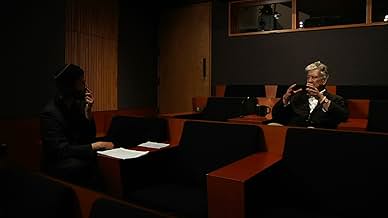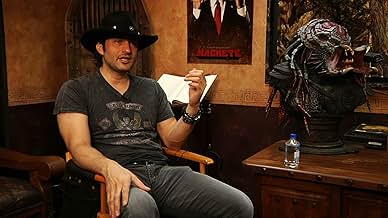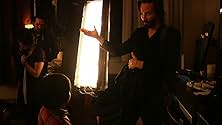PUNTUACIÓN EN IMDb
7,6/10
14 mil
TU PUNTUACIÓN
Añade un argumento en tu idiomaThe documentary investigates the history, process and workflow of both digital and photochemical film creation.The documentary investigates the history, process and workflow of both digital and photochemical film creation.The documentary investigates the history, process and workflow of both digital and photochemical film creation.
- Dirección
- Guión
- Reparto principal
- Premios
- 1 nominación en total
Reseñas destacadas
I tend to read proper film critics for their opinions not only on specific films but also essays on themes, genres, movements and so on; I consider myself a total amateur on such subjects but I find it interested to listen to those who are not. Coming to Side by Side I wasn't sure if it would be too dry for me to get into or if it would be too simplistic for me to stay interested in for just under two hours. The film essentially looks at the transition from celluloid to digital in film making – from filming through to post through to projection in the cinema and the means of delivery to the viewer. It is an ambitious goal but it is one that it does very well and in a way that flows and is accessible.
I guess that for those with a real good working knowledge of the technology and the process, it may be too simplistic but for the casual viewer and enjoyer of films, there is enough detail here to engage and interest, but not so much that I felt overwhelmed with technical detail that I wasn't interested in. The film is really made up of Reeves acting as interviewer with a range of people involved in all the various aspects of the process – directors, cinematographers, editors, camera manufacturers etc. and he does a decent job, but not a great job in this regard. Fortunately this is not really his main role because it certainly seems that as producer he has helped Kenneally get a lot of very famous people to agree to be in the film. This range of talent and opinion makes for an interesting film, so while we follow development of things over time, we tend to get both sides as the title suggests.
Most of the contributors are interesting and their soundbites are well edited and the film itself is put together very well so that it covers time and technology in a way that makes sense, engages and never outstays its welcome. It probably won't do much for the technical enthusiast but for fans of film and cinema it is very much worth seeing as entertainment and education.
I guess that for those with a real good working knowledge of the technology and the process, it may be too simplistic but for the casual viewer and enjoyer of films, there is enough detail here to engage and interest, but not so much that I felt overwhelmed with technical detail that I wasn't interested in. The film is really made up of Reeves acting as interviewer with a range of people involved in all the various aspects of the process – directors, cinematographers, editors, camera manufacturers etc. and he does a decent job, but not a great job in this regard. Fortunately this is not really his main role because it certainly seems that as producer he has helped Kenneally get a lot of very famous people to agree to be in the film. This range of talent and opinion makes for an interesting film, so while we follow development of things over time, we tend to get both sides as the title suggests.
Most of the contributors are interesting and their soundbites are well edited and the film itself is put together very well so that it covers time and technology in a way that makes sense, engages and never outstays its welcome. It probably won't do much for the technical enthusiast but for fans of film and cinema it is very much worth seeing as entertainment and education.
Hollywood insiders are aware of a battle that has been brewing for quite sometime now: the technology to capture the image has two camps- film and digital and each are perhaps overwhelming the other. Film is photomchemical and the method by which cinema has been created and projected for all these years (since the late 1890). Digital cameras are new on the block and because they can do everything a film camera can but with less production costs, they are vying to be the medium every director chooses. Keanu Reeves questions industry insiders from top directors and cinematographers and gets a honest non biased overview. This is a good watch for anyone interested in the technical and "behind the camera" scenes of making of film and television. The documentary is precise and educative.
Film is dead, or is it? With major distributors in USA going digital this year in lieu of film, the death knell has been sounded that perhaps it's not too long before celluloid film projection is a thing of the past, and with it comes digital filmmaking, production, distribution and projection. But does it have to be that way, and can both mediums co-exist to satisfy the various sections of the creative market? Produced by Justin Szlasa and Keanu Reeves, the latter who was here in Hong Kong for a masterclass, Side by Side is the documentary written and directed by Christopher Kenneally, that deep dives into both sides of the equation.
And who better than to interview those who have dabbled with both mediums? What made this documentary a compelling watch is Keanneally's ability to cover an entire range of topics related to this issue, tracing the history of both mediums, especially the digital one, and giving depth into backgrounds, reasons and rationale taken from those who have dealt with both old and new technologies. Having Keanu Reeves turn into the interviewer works in both levels of attracting the casual viewer into watching this, as well as on the interview front, made it easy for filmmakers to relate and open up to one of their own, as they talk about the medium, how it impacts filmmaking, and from acting in front of the camera, the camera technologies themselves, and the case for distribution and exhibition, weighing in on the pros and cons at every stage.
These filmmakers are none other than the who's who of Hollywood luminaries, such as James Cameron, George Lucas, Martin Scorsese, David Fincher, Robert Rodriguez, Christopher Nolan, Danny Boyle, Richard Linklaer, David Lynch, Joel Schumacher, Steven Soderbergh, Lars von Trier, and both Lana and Andy Wachowski whom Keanu Reeves made the prolific Matrix trilogy. And it's not just directors, but also containing interviews with editors and cinematographers such as one of my personal favourites Wally Pfister, who together with Nolan stand on the side of celluloid, famously resisting Warner Bros' attempt to turn their lucrative Dark Knight projects into the digital or 3D formats.
While one may get distracted by the star studded lineup, we get to see how each are so passionate about the medium they believe in, and the compelling arguments they make for and against their case, listening from the horse's mouth of those who are in the industry, together with the satisfaction gained and challenges they face. For instance, like Fincher, digital filmmaking gave rise to cameras that can be designed to cater to the nature of the shots he had intended, without which films like The Social Network, or The Girl With the Dragon Tattoo, cannot achieve certain shots or have the camera angles so desired. Everyone provided their own memorable soundbites when they engage in this discourse, so much so that you'd soon find everything that's being said becoming terribly sexy and seductive in their arguments.
But Conneally does an excellent job in not allowing any one filmmaker to run away with the presentation he so decided, allowing arguments to be made and the viewer to form his own conclusion. The pace moves at breakneck speed, hardly every pausing just like how digital filmmaking has directors almost never calling it quits because the medium has run out, as you the audience will definitely find an area in which you have little knowledge of, but thanks to this film and its incredible breadth adopted for its scope, you're bound to come out of it a little bit enlightened about the entire technical process, the evolution of filmmaking technologies, as well as gain new found appreciation for those who are so passionate in their filmmaking that it's automatically shown in the final cut they put out for projection.
No film related topic was taboo, as the documentary also took a look at archival processes, which contains a little bit of an irony. If there's a flaw to this wonderfully made documentary, it will be that its focus is still inherently Hollywood's own, since there is a distinct lack of interviews and gathering of content outside of Tinseltown. Perhaps an apt follow up to this would warrant a lot more interviews to be done with filmmakers around the world, but I'm guessing most of the responses will already have been covered by the mammoth scope here (and whose filmmakers are at the forefront of technology given geeks like Cameron), and at best appear as supplemental discs should this ever be released on DVD format sometime soon. Definitely highly recommended viewing for everyone, film buffs or otherwise, with great material yet to be seen in upcoming films included as well.
And who better than to interview those who have dabbled with both mediums? What made this documentary a compelling watch is Keanneally's ability to cover an entire range of topics related to this issue, tracing the history of both mediums, especially the digital one, and giving depth into backgrounds, reasons and rationale taken from those who have dealt with both old and new technologies. Having Keanu Reeves turn into the interviewer works in both levels of attracting the casual viewer into watching this, as well as on the interview front, made it easy for filmmakers to relate and open up to one of their own, as they talk about the medium, how it impacts filmmaking, and from acting in front of the camera, the camera technologies themselves, and the case for distribution and exhibition, weighing in on the pros and cons at every stage.
These filmmakers are none other than the who's who of Hollywood luminaries, such as James Cameron, George Lucas, Martin Scorsese, David Fincher, Robert Rodriguez, Christopher Nolan, Danny Boyle, Richard Linklaer, David Lynch, Joel Schumacher, Steven Soderbergh, Lars von Trier, and both Lana and Andy Wachowski whom Keanu Reeves made the prolific Matrix trilogy. And it's not just directors, but also containing interviews with editors and cinematographers such as one of my personal favourites Wally Pfister, who together with Nolan stand on the side of celluloid, famously resisting Warner Bros' attempt to turn their lucrative Dark Knight projects into the digital or 3D formats.
While one may get distracted by the star studded lineup, we get to see how each are so passionate about the medium they believe in, and the compelling arguments they make for and against their case, listening from the horse's mouth of those who are in the industry, together with the satisfaction gained and challenges they face. For instance, like Fincher, digital filmmaking gave rise to cameras that can be designed to cater to the nature of the shots he had intended, without which films like The Social Network, or The Girl With the Dragon Tattoo, cannot achieve certain shots or have the camera angles so desired. Everyone provided their own memorable soundbites when they engage in this discourse, so much so that you'd soon find everything that's being said becoming terribly sexy and seductive in their arguments.
But Conneally does an excellent job in not allowing any one filmmaker to run away with the presentation he so decided, allowing arguments to be made and the viewer to form his own conclusion. The pace moves at breakneck speed, hardly every pausing just like how digital filmmaking has directors almost never calling it quits because the medium has run out, as you the audience will definitely find an area in which you have little knowledge of, but thanks to this film and its incredible breadth adopted for its scope, you're bound to come out of it a little bit enlightened about the entire technical process, the evolution of filmmaking technologies, as well as gain new found appreciation for those who are so passionate in their filmmaking that it's automatically shown in the final cut they put out for projection.
No film related topic was taboo, as the documentary also took a look at archival processes, which contains a little bit of an irony. If there's a flaw to this wonderfully made documentary, it will be that its focus is still inherently Hollywood's own, since there is a distinct lack of interviews and gathering of content outside of Tinseltown. Perhaps an apt follow up to this would warrant a lot more interviews to be done with filmmakers around the world, but I'm guessing most of the responses will already have been covered by the mammoth scope here (and whose filmmakers are at the forefront of technology given geeks like Cameron), and at best appear as supplemental discs should this ever be released on DVD format sometime soon. Definitely highly recommended viewing for everyone, film buffs or otherwise, with great material yet to be seen in upcoming films included as well.
This is a documentary that every film enthusiast must watch. It will give you an understanding of the ways a feature film is shot and projected. To the unaware today most movies are shot on digital cameras as opposed to the photochemically styled film cameras of the past days. Both have their plus and minuses and in this documentary, Keanu Reeves goes about explaining the differences of the format and the opinion of most famous filmmakers on the subject. Featuring everyone from James Cameron to Martin Scorsese Side by Side is a great look at the technical aspect of cinema.
"People love great stories. They love to get into a world and have an experience. And how they get it—it doesn't really matter." David Lynch
Which do you prefer: photochemical or digital projection for your movies? If you're geeky enough, you really care; if not, like me, you want a great story and characters with a crisp image that complements the theme, regardless of whether or not it's film. As for 3D, I can live without it.
Christopher Kenneally's interesting Side by Side documentary presents filmmakers like George Lucas who claim celluloid is dead and those like Christophe Nolan who vow not yet to trade his "oil paints for crayons." The film does a credible job presenting both sides with a slight edge to a future of all digital and a pessimistic take on film as an eventual curiosity.
Among the talking heads are avatars of photography and direction with an occasional producer and actress to get closer to us viewers, who are never questioned even though we are the ultimate arbiters. But the experts have valid and provocative points: the film advocates tout its warmth and color possibilities while the digital dudes trumpet the ease, low cost, and creative infinity. The film does an entertaining job of presenting the sides.
Both sides agree archiving remains a pressing and often neglected issue. Although Martin Scorsese is at the forefront of saving film, no one else has yet taken the case of digital preservation with his passion. The documentary doesn't take enough time on this issue especially since I thought something like my external hard drive would already be in the mix. Not. Apparently even digital imaging can break down in storage.
Oh, well, I'm with Lynch: Give me a super story and beautiful image and let the geeks and gods work out the details.
Which do you prefer: photochemical or digital projection for your movies? If you're geeky enough, you really care; if not, like me, you want a great story and characters with a crisp image that complements the theme, regardless of whether or not it's film. As for 3D, I can live without it.
Christopher Kenneally's interesting Side by Side documentary presents filmmakers like George Lucas who claim celluloid is dead and those like Christophe Nolan who vow not yet to trade his "oil paints for crayons." The film does a credible job presenting both sides with a slight edge to a future of all digital and a pessimistic take on film as an eventual curiosity.
Among the talking heads are avatars of photography and direction with an occasional producer and actress to get closer to us viewers, who are never questioned even though we are the ultimate arbiters. But the experts have valid and provocative points: the film advocates tout its warmth and color possibilities while the digital dudes trumpet the ease, low cost, and creative infinity. The film does an entertaining job of presenting the sides.
Both sides agree archiving remains a pressing and often neglected issue. Although Martin Scorsese is at the forefront of saving film, no one else has yet taken the case of digital preservation with his passion. The documentary doesn't take enough time on this issue especially since I thought something like my external hard drive would already be in the mix. Not. Apparently even digital imaging can break down in storage.
Oh, well, I'm with Lynch: Give me a super story and beautiful image and let the geeks and gods work out the details.
¿Sabías que...?
- PifiasIdentifies Distrito 9 (2009) as being shot on the Sony F23. It was actually shot on Red One cameras.
- Citas
Martin Scorsese: The only way you can make sure that a film or anything on the moving image is going to be around sixty or seventy years from now, interestingly enough, ironically enough, is celluloid.
- ConexionesFeatured in Film '72: Episodio fechado 13 febrero 2013 (2013)
Selecciones populares
Inicia sesión para calificar y añadir a tu lista para recibir recomendaciones personalizadas
- How long is Side by Side?Con tecnología de Alexa
Detalles
Taquilla
- Recaudación en Estados Unidos y Canadá
- 58.825 US$
- Fin de semana de estreno en EE. UU. y Canadá
- 6956 US$
- 19 ago 2012
- Recaudación en todo el mundo
- 67.054 US$
- Duración1 hora 39 minutos
- Color
- Relación de aspecto
- 1.85 : 1
Contribuir a esta página
Sugerir un cambio o añadir el contenido que falta

Principal laguna de datos
By what name was El impacto del cine digital (2012) officially released in Canada in English?
Responde




































